 Built in 1799, by Maharaja Sawai Pratap Singh the 'Hawa Mahal', Palace of the Wind, is one of the major landmarks of Jaipur. It is an integral part of the City Palace, an extension of the Zenana (women's chambers) standing away from the main complex. This five storey building of unusual architecture designed by Lal Chand Usta, is a stunning example of Rajput artistry made of red and pink sand stone, beautifully outlined with white borders and motif's painted with quick lime. The monument with a spectacular view of Jaipur city with road avenues, intersections and colourful crowds in the market, was originally conceived with the aim of enabling ladies of the royal household to watch the everyday life and royal processions in the city without being seen by others.
Built in 1799, by Maharaja Sawai Pratap Singh the 'Hawa Mahal', Palace of the Wind, is one of the major landmarks of Jaipur. It is an integral part of the City Palace, an extension of the Zenana (women's chambers) standing away from the main complex. This five storey building of unusual architecture designed by Lal Chand Usta, is a stunning example of Rajput artistry made of red and pink sand stone, beautifully outlined with white borders and motif's painted with quick lime. The monument with a spectacular view of Jaipur city with road avenues, intersections and colourful crowds in the market, was originally conceived with the aim of enabling ladies of the royal household to watch the everyday life and royal processions in the city without being seen by others.
Showing posts with label tourism place. Show all posts
Showing posts with label tourism place. Show all posts
Thursday, June 27, 2013
Hawa Mahal ( Jaipur, India)
 Built in 1799, by Maharaja Sawai Pratap Singh the 'Hawa Mahal', Palace of the Wind, is one of the major landmarks of Jaipur. It is an integral part of the City Palace, an extension of the Zenana (women's chambers) standing away from the main complex. This five storey building of unusual architecture designed by Lal Chand Usta, is a stunning example of Rajput artistry made of red and pink sand stone, beautifully outlined with white borders and motif's painted with quick lime. The monument with a spectacular view of Jaipur city with road avenues, intersections and colourful crowds in the market, was originally conceived with the aim of enabling ladies of the royal household to watch the everyday life and royal processions in the city without being seen by others.
Built in 1799, by Maharaja Sawai Pratap Singh the 'Hawa Mahal', Palace of the Wind, is one of the major landmarks of Jaipur. It is an integral part of the City Palace, an extension of the Zenana (women's chambers) standing away from the main complex. This five storey building of unusual architecture designed by Lal Chand Usta, is a stunning example of Rajput artistry made of red and pink sand stone, beautifully outlined with white borders and motif's painted with quick lime. The monument with a spectacular view of Jaipur city with road avenues, intersections and colourful crowds in the market, was originally conceived with the aim of enabling ladies of the royal household to watch the everyday life and royal processions in the city without being seen by others.
India Gate
Wednesday, June 26, 2013
Qutub Minar
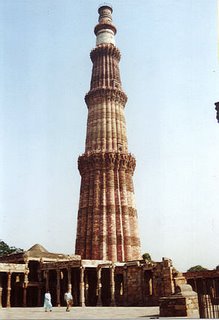
Qutub Minar was raised by Qutub-ud-Din in 1199 AD, either as a victory tower or as a minaret to the adjacent mosque. It is one of the finest Islamic structures ever raised and is Delhi's most recognised landmark. However, only the first storey was accomplished by Qutb-ud-din and the rest were built by his successor and son-in-law, IItumish (1211-36 AD). The two circular stories in white marble were built by Firozshah Tughlaq in 1368, who used marble to face the redstone. Qutub Minar is a red sandstone tower beautified with intricate and striking carvings and is inscribed with verses from the holy Quran. Its projecting balconies with inscriptional decorative bands on different storeys heighten its decorative effect.
An earthquake in the early 19th century destroyed its crowning cupola. An English engineer, Major Robert Smith, replaced it in 1829, but his addition looked so grossly out of place that it was removed in 1848 by Governor-General Lord Hardings. It now stands on the lawns and has acquired the sobriquet Smith's Folly.
Till a while ago, the base of the Minar had a number of glass plates banded by concrete, installed by the Archaeological Survey of India to monitor earthquakes.
Nainital, India
London Canal Museum
 At the London Canal Museum you can see inside a narrowboat cabin, learn about the history of London's canals, about the cargoes carried, the people who lived and worked on the waterways, and the horses that pulled their boats. Peer down into the unique heritage of a huge Victorian ice well used to store ice imported from Norway and brought by ship and canal boat to be stored. The museum is an attraction housed in a former ice warehouse built in about 1862-3 for Carlo Gatti, the famous ice cream maker, and features the history of the ice trade and ice cream as well as the canals. This is the only London museum of inland waterways and is situated at King's Cross, an accessible central London location.
At the London Canal Museum you can see inside a narrowboat cabin, learn about the history of London's canals, about the cargoes carried, the people who lived and worked on the waterways, and the horses that pulled their boats. Peer down into the unique heritage of a huge Victorian ice well used to store ice imported from Norway and brought by ship and canal boat to be stored. The museum is an attraction housed in a former ice warehouse built in about 1862-3 for Carlo Gatti, the famous ice cream maker, and features the history of the ice trade and ice cream as well as the canals. This is the only London museum of inland waterways and is situated at King's Cross, an accessible central London location.
Tuesday, June 25, 2013
Easter Island
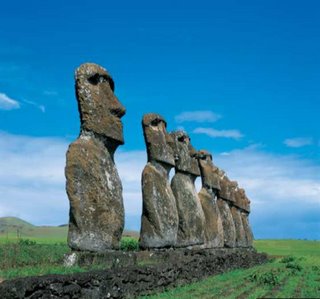 It is one of the most isolated islands in the world but 1200 years ago a double-hulled canoe filled with seafarers from a distant culture landed upon its shores. Over the centuries that followed a remarkable society developed in isolation on the island. For reasons still unknown they began carving giant statues out of volcanic rock. These monuments, known, as "moai" are some of the most incredible ancient relics ever discovered. The people of Easter Island called themselves the Rapa Nui. Where did they come from and why did they disappear? Science has learned much about the enigma of Easter Island and has put to rest some of the more bizarre theories, but questions and controversies remain. Explore this site to get the latest information on the island's history and current research.
It is one of the most isolated islands in the world but 1200 years ago a double-hulled canoe filled with seafarers from a distant culture landed upon its shores. Over the centuries that followed a remarkable society developed in isolation on the island. For reasons still unknown they began carving giant statues out of volcanic rock. These monuments, known, as "moai" are some of the most incredible ancient relics ever discovered. The people of Easter Island called themselves the Rapa Nui. Where did they come from and why did they disappear? Science has learned much about the enigma of Easter Island and has put to rest some of the more bizarre theories, but questions and controversies remain. Explore this site to get the latest information on the island's history and current research.
The Golden Temple

The Golden Temple is the ultimate Sikh pilgrimage. The Harmandir Sahib, as it is traditionally known, actually means the temple of Hari or the Supreme God. Also known as the Darbar Sahib, the stupendous, architectural phenomena is located at the city of Amritsar (INDIA). The temple's exterior is gold-plated and the structure stands in the middle of a square tank. There is a causeway across the Pool of Nectar to reach the Temple. The shrine is symbolical of the doctrines of Sikhism. It also represents the magnificent strength of all the Sikhs. The amazing thing about Harmandir Sahib is that it has doorways on all four sides, meant to be open for the people of the all four castes. All over the, the Sikhs always look forward to visit to the magnificent temple and offer prayers at the Harmandir Sahib.
Gateway of India

The Gateway of India is a monument located in Mumbai, India. Located on the waterfront in South Mumbai, the Gateway is a basalt arch 26 metres high. The Gateway is traditionally the first thing visitors arriving by boat would see of Bombay. Behind the Gateway steps lead down to the waterfront, where boat trips can be had to locations such as Elephanta Island. The Taj Mahal Hotel adjacent is also a major landmark, and the site is a popular tourist destination.
The Gateway is built from yellow kharodi basalt and reinforced concrete. While Indo-Saracenic in architectural style, elements are derived from the Muslim architectural styles of 16th century Gujarat. The central dome is 15 metres in diameter and 26 metres above ground at its highest point. The whole harbour front was realigned in order to come in line with a planned esplanade which would sweep down to the centre of the town. The cost of the construction was Rs. 21 lakhs, borne mainly by the Government of India. For lack of funds, the approach road was never built, and so the Gateway stands at an angle to the road leading up to it.
Monday, June 24, 2013
Grand Canyons

Grand Canyon is unmatched throughout the world for the vistas it offers to visitors on the rim. It is not the deepest canyon in the world. Both the Barranca del Cobre in northern Mexico and Hell's Canyon in Idaho are deeper. But Grand Canyon is known for its overwhelming size and its intricate and colorful landscape. Geologically it is significant because of the thick sequence of ancient rocks that are beautifully preserved and exposed in the walls of the canyon. These rock layers record much of the early geologic history of the North American continent. Grand Canyon is also one of the most spectacular examples of erosion in the world.
Jim Corbett National Park India
 Jim Corbett National Park India had the proud distinction of being chosen as the venue for the inauguration of Project Tiger in India; earlier part of Uttar Pradesh now comes under Uttaranchal, the newly found state. Jim Corbett National Park India is home to a variety of flora and fauna, Corbett park is famous for its wild population of Tigers, Leopards and Elephants. Corbett Tiger Reserve has a great variety of fauna on account of habitat diversity. In the Jim Corbett National Park are found 110 tree species, 50 mammals' species, 580 bird species and 25 reptile species.
Jim Corbett National Park India had the proud distinction of being chosen as the venue for the inauguration of Project Tiger in India; earlier part of Uttar Pradesh now comes under Uttaranchal, the newly found state. Jim Corbett National Park India is home to a variety of flora and fauna, Corbett park is famous for its wild population of Tigers, Leopards and Elephants. Corbett Tiger Reserve has a great variety of fauna on account of habitat diversity. In the Jim Corbett National Park are found 110 tree species, 50 mammals' species, 580 bird species and 25 reptile species.Jim Corbett National Park India has always been famous for their resident tigers. Initially Jim Corbett National Park reserve was named as 'Hailey National Park' in 193
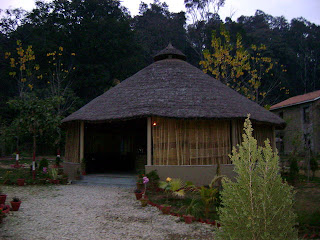 6. Jim Corbett National Park was renamed in 1954-55 as 'Ramganga National Park' and again in 1955-56 as 'Jim Corbett National Park' after Jim Corbett who hunted down tigers that had turned man-eaters, between 1907 to 1939. Jim Corbett National Park India is the 1st and oldest National Park of India. Jim Corbett National Park India was one of the nine Tiger Reserves created at the launch of the Project Tiger in 1973.
6. Jim Corbett National Park was renamed in 1954-55 as 'Ramganga National Park' and again in 1955-56 as 'Jim Corbett National Park' after Jim Corbett who hunted down tigers that had turned man-eaters, between 1907 to 1939. Jim Corbett National Park India is the 1st and oldest National Park of India. Jim Corbett National Park India was one of the nine Tiger Reserves created at the launch of the Project Tiger in 1973.Jim Corbett National Park India is a haven for Tigers as well as its prey, which include four kinds of Deer, Wild Boar and some lesser-known animals. Leopards are mostly found in the hilly areas of the Corbett park. Some nocturnal cats found here are the Leopard Cat, Jungle Cat and Fishing Cat. Sloth Bear is found in the lower regions of the park while the Himalayan Black Bear is seen in the higher hills only. The Dole or Wild Dog, though they can be seen in the southern areas of the park along with the Jackal. Some of the smaller residents of the park are Himalayan Palm Civet, Indian Gray Mongoose,  Common Otter, Blacknaped Hare and Porcupine. Elephants are among one of the main attractions of Jim Corbett Park. Along the Ramganga River shores, one can spot the long-snouted, fish-eating Gharial Crocodile and the 'Mugger' Crocodile. Also seen on the rocky hillsides is the Ghoral or Goat Antelopes. The Langur and Rhesus Monkeys are well distributed through out the jim corbett national park and warning the whole Jungle with alarm calls when they see either a Tiger or Leopard from tree-top perches.
Common Otter, Blacknaped Hare and Porcupine. Elephants are among one of the main attractions of Jim Corbett Park. Along the Ramganga River shores, one can spot the long-snouted, fish-eating Gharial Crocodile and the 'Mugger' Crocodile. Also seen on the rocky hillsides is the Ghoral or Goat Antelopes. The Langur and Rhesus Monkeys are well distributed through out the jim corbett national park and warning the whole Jungle with alarm calls when they see either a Tiger or Leopard from tree-top perches.
 Common Otter, Blacknaped Hare and Porcupine. Elephants are among one of the main attractions of Jim Corbett Park. Along the Ramganga River shores, one can spot the long-snouted, fish-eating Gharial Crocodile and the 'Mugger' Crocodile. Also seen on the rocky hillsides is the Ghoral or Goat Antelopes. The Langur and Rhesus Monkeys are well distributed through out the jim corbett national park and warning the whole Jungle with alarm calls when they see either a Tiger or Leopard from tree-top perches.
Common Otter, Blacknaped Hare and Porcupine. Elephants are among one of the main attractions of Jim Corbett Park. Along the Ramganga River shores, one can spot the long-snouted, fish-eating Gharial Crocodile and the 'Mugger' Crocodile. Also seen on the rocky hillsides is the Ghoral or Goat Antelopes. The Langur and Rhesus Monkeys are well distributed through out the jim corbett national park and warning the whole Jungle with alarm calls when they see either a Tiger or Leopard from tree-top perches.Hotels in Jim Corbett National Park can divided in four category: Resorts, Hotels and Fore
 st Rest Houses, providing a higher standard of accommodation at a price as well as guides for expeditions in the forests, which can be as rich in wildlife as the Jim Corbett National Park, without the restrictions.
st Rest Houses, providing a higher standard of accommodation at a price as well as guides for expeditions in the forests, which can be as rich in wildlife as the Jim Corbett National Park, without the restrictions.There are many accommodation facilities at Ramnagar as well as at the Corbett National Park. Being one of the most frequently visited parks in the country, the forest department and other agencies have their hotels, lodges, rest houses, log huts for the visitors.
Forest rest houses, log huts etc at Dhikala, forest rest houses at Sarapduli, Bijrani, and Ghairal offer some of the best stay in the region. There are many resorts along the periphery of the park which take the load off the governments accommodation facilities. To stay at the government hotels, rest houses etc make sure that reservations are done well in advance as the pressure is really high during the tourist seasons.
In order to make the travel tour to Corbett even more joyful we at Corbett P
 ark offer just the right kind of accommodation for you and your family or friends in Corbett. We at Corbett Park can customize the tour package and offer the corbett jungle resort and hotel accommodation. As Corbett is quite popular destination during the tourist season, it is better to get reservation before reaching there.
ark offer just the right kind of accommodation for you and your family or friends in Corbett. We at Corbett Park can customize the tour package and offer the corbett jungle resort and hotel accommodation. As Corbett is quite popular destination during the tourist season, it is better to get reservation before reaching there.The park normally opens at 0600 hrs in the morning and is open till about 1100 hrs in the morning. In the afternoon the park timings usually are from 1430 to 1730. However depending on the season the timings change locally which the forest authorities of Corbett notify.
Cape Town
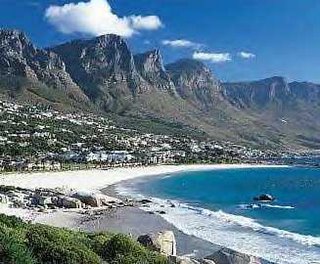
Cape Town is one of the few large cities where the periphery is cosmopolitan and developed and the center of the city is actual wilderness. It's an interesting and beautiful variation on the usual city experience, due to the fact that Cape Town nestles up against Table Mountain (3563 ft. high), a wildlife preserve directly in the middle of town.
Cape Town has a Mediterranean climate with an average temperature range of 7-27 degrees Celsius. Generally the winter months are between April and August with summer being from September to March. Summers are warm and dry and winters cool and wet.
Cape Town is two hours ahead of Greenwich Mean Time.
Spectacular tourism attractions like beaches, the famous Kirstenbosch botanical gardens and rugged Table Mountain are minutes away from the city centre.
If you love nature, Cape Town has remarkable natural areas with brilliant hiking, birdwatching, whale watching, and all sorts of other nature-related activities and tourism attractions.
There are excellent sports facilities including many great golf courses, gyms, tennis courts, indoor and outdoor pools. Watersports enthusiasts can surf, swim, dive, waterski, watersurf, kayak or paddleski at one of the many beaches.
If you enjoy adrenaline rushes, Cape Town is a mecca for adventure activities from mountain biking to shark-diving and hang-gliding.
If you prefer more relaxed activities than you will appreciate the cultural side of Cape Town's tourism attractions. Superb museums, a planetarium, and the country's best art galleries are situated in the town. Township tours and street performers will introduce you to the "people's culture".
The city's cultural diversity is reflected in everything from the craft items and clothing to the restaurants, nightlife and tourism attractions.
The nightlife is the most happening in Africa, with clubs and pubs to suit all tastes. You can dance to any sort of music, even "kwaito", which is a funky township music related to reggae.
For other fun seekers, Cape Town offers a huge new theme park with roller coasters and water rides. Alternatively you can gamble the night away at Cape Town's casino.
Sunday, June 23, 2013
Wild Wadi Water Park

The Wild Wadi Water Park is situated in Jumeirah, an area in Dubai.
Wild Wadi is an outdoor water park with heated wave pool, water slides and artificial surfing machines. The water park also has a 18 metre high water fall, which every hour on the hour spills its load onto the guests below. The water park also has its two shops and three restaurants. The park also includes the largest water slide outside of North America.
Anne Frank House

Anne Frank was one of the Jewish victims of Nazi persecution during the second world war. After Nazi Germany invaded the Netherlands in 1940, increasingly severe anti-Jewish measures began here as well. The Frank family tried to escape by going into hiding. On July 1942, Otto Frank, Edith Frank-Hollander and their daughters Margot and Anne hid in this building on the Prinsengracht. They where later joined by Mr. and Mrs Daan, their sun Peter and Mr. Dussel. The building consists of two parts : a front house and a back annex. Otto Frank's business was located in the front house. The uppermost floors of the back anexe became the hiding place. After more than two years the group was betrayed and deported. Anne and Margot died of typhus in Bergen-Belsen in March 1945, only a few weeks before this concentration camp was liberated. Otto Frank, the only member of the group to survive, returned after the war.
During the hiding period Anne Frank kept a diary. In it she described daily life in the back anexe, the isolation and the fear of discovery. Anne's diary survived the war: after the betrayal it was found by Miep Gies, one of the helpers. When it was confirmed that Anne would not be returning, Miep gave the manuscripts to Otto Frank. In 1947 the first Dutch edition appeared. Since then the diary has been published in more then 55 languages.
The Cradle of Humankind, Gauteng, South Africa
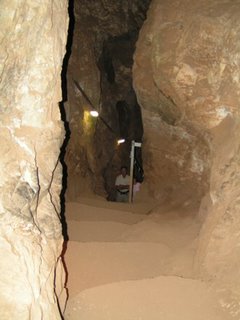
The Cradle of Humankind, Gauteng(Only 45 minutes from Johannesburg), South Africa: The Cradle of Humankind Site comprises a strip of a dozen dolomitic limestone caves containing the fossillised remains of ancient forms of animals, plants and most importantly, hominids. The dolomite in which the caves formed, started out as coral reefs growing in a worm shallow sea about 2.3 billion years ago.
At a depth of 40 metres is a perfectly calm underground lake. Local African tribes regard it with awe, believing that the water has medicinal properties and can even cure blindness.
Tribespeople hold ceremonies at the edge of the lake, during which water is carried away for treatment of the sick.
The underground lake with crystal clear water is the only one of its kind in the country.
Saturday, June 22, 2013
Darjeeling: A cool place to visit this year
 Darjeeling owes' its grandeur to its natural beauty, its clean fresh mountain air and above all, the smiling resilient people for whom it is a home. Known for its natural splendor, Darjeeling's best gift to its' visitors is the dawn of a new day. The mountains awaken first with a tentative peeking of the sun. A steep ride, five kilometers from Ghoom, or an invigorating walk up a steep incline, leads sun worshippers to Tiger Hill. The air is chilly with darkness and damp.
Darjeeling owes' its grandeur to its natural beauty, its clean fresh mountain air and above all, the smiling resilient people for whom it is a home. Known for its natural splendor, Darjeeling's best gift to its' visitors is the dawn of a new day. The mountains awaken first with a tentative peeking of the sun. A steep ride, five kilometers from Ghoom, or an invigorating walk up a steep incline, leads sun worshippers to Tiger Hill. The air is chilly with darkness and damp.Darjeeling offers all that is precious in nature-the hush of the hills, the green depth of the forest and the majesty of the mountains. It is a tradition while visiting Darjeeling to go to the Tiger Hill before daybreak to see the first rays of the sun strike the mountains. Another tradition is to spend a few hours everyday taking in the air at the Observatory
Hill, the popular meeting place for tourists as well as residents. The Himalayan Mountaineering Institute is a paradise for trekkers. You can, if you wish, go on short or long treks, depending on your stamina and enthusiasm.
For witnessing the sheer magnificence of mountains, unsullied and pristine, nothing compares with a visit to the famous hill station of Darjeeling in West Bengal. Even as you drive up the curvaceous roads or take the famous toy train to your destination, you will be awestruck by the resplendence of nature. Go through our tour offers for Darjeeling and decide which one is the best for you. If you are not looking for the one given here, call us.
Mirik Lake,Darjeeling, Darjeeling Travel, Darjeeling Hotels, Darjeeling Tours, Darjeeling Tourism, Visit Darjeeling, Darjeeling all-inclusive tours, Darjeeling travel package Darjeeling is well linked by Air, Road and Rail network. There are flights from Calcutta to Bagdogra which is 90 kilometers from Darjeeling. The nearest railhead is Siliguri. The Toy train runs from New Jalpaiguri/Siliguri. Darjeeling owes' its grandeur to its natural beauty, its clean fresh mountain air and above all, the smiling resilient people for whom it is a home. Known for its natural splendor, Darjeeling's best gift to its' visitors is the dawn of a new day. The mountains awaken
first with a tentative peeking of the sun. A steep ride, five kilometers from Ghoom, or an invigorating walk up a steep incline, leads sun worshippers to Tiger Hill. The air is chilly with darkness and damp.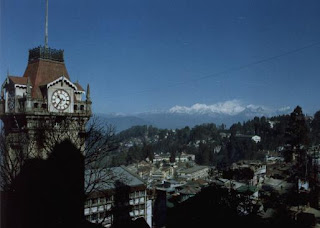

Darjeeling offers all that is precious in nature-the hush of the hills, the green depth of the forest and the majesty of the mountains. It is a tradition while visiting Darjeeling to go to the Tiger Hill before daybreak to see the first rays of the sun strike the mountains. Another tradition is to spend a few hours everyday taking in the air at the Observatory Hill, the popular meeting place for tourists as well as residents. The Himalayan Mountaineering Institute is a paradise for trekkers. You can, if you wish, go on short or long treks, depending on your stamina and enthusiasm.
For witnessing the sheer magnificence of mountains, unsullied and pristine, nothing compares with a visit to the famous hill station of Darjeeling in West Bengal. Even as you drive up the curvaceous roads or take the famous toy train to your destination, you will be awestruck by the resplendence of nature. Go through our tour offers for Darjeeling and decide which one is the best for you.
Darjeeling is well linked by Air, Road and Rail network. There are flights from Calcutta to Bagdogra which is 90 kilometers from Darjeeling. The nearest railhead is Siliguri. The Toy train runs from New Jalpaiguri/Siliguri.
Melbourne Zoo

Opened in 1862, Melbourne Zoo is the oldest in Australia. More than 350 animal species from around the world are on display in the zoo’s attractive enclosures and botanical settings.
Visitors can wander through an African and Asian rainforest displaying gorillas, pygmy hippopotamus, mandrills, tigers and otters, or see an extensive collection of Australian animals including koalas, kangaroos, wombats and platypus. Other highlights include the steamy Butterfly House (where hundreds of Australian butterflies alight upon visitors), the Wonderful New World of Bugs, the Trail of the Elephants and regular meet-the-keeper opportunities throughout the day.
During the summer months, the zoo stays open until 9.30pm for ‘Zoo Twilights’, when live music, concerts, meals and longer animal displays take place.
Guided tours are available daily between 10am and 3pm, and are operated by Friends of the Zoo volunteer guides, who are extensively trained and qualified to answer your questions. Bookings are required for large groups.
Canada's National Tower
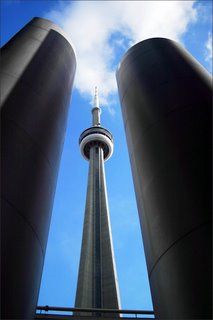
Canada's National Tower is the tallest tower and free-standing structure in the world, at 553.33 metres (1,815.39 feet). It is located in the city of Toronto, Ontario, Canada, and is considered the signature icon of the city (Geographic coordinates: 43° 38′ 33.24″ N, 79° 23′ 13.7″ W). The CN Tower attracts over 2 million visitors annually.
Construction on the CN Tower started on February 6, 1973 by Canadian National Railway who wanted to build a large TV and radio communication platform to service the Greater Toronto Area and also to demonstrate the levels, revolving restaurant, and giftshop. Key project team members were NCK Engineering as structural engineer; John Andrews Architects; Webb, Zerafa, Menkes, Housden Architects; Foundation Building Construction and Canron (Eastern Structural Division). The project proceeded 24 hours a day, five days a week for 40 months with 1,537 workers involved in the project, finally opening to the public on June 26, 1976. The structure's microwave receivers for distant signals are housed at 338 metres, and the top of the transmission antenna is at the apex of the tower. The construction costs of approximately $300 million CAD (today's equivalent) were repaid in fifteen years.
A metal staircase with 1,776 steps reaches the Sky Pod level (447 m; 147 stories) and is the tallest metal staircase on earth. These stairs are intended for emergency use and are not open to the public, except for twice a year for charity stairclimb events: around Earth Day in the spring by the World Wildlife Fund; and in the fall by the United Way's Toronto chapter. The average climber takes approximately 30 minutes to climb to the base of the radome (the white ring around the bottom of the main pod), but the fastest climb on record is 7 minutes 52 seconds.
Friday, June 21, 2013
Petronas Twin Towers

Each of the twin Petronas Towers is 88 stories plus an additional architectural point (at 1242 feet), plus a tall spire to 1483 feet. Compare to the Sears Tower in Chicago which is 110 stories, and the twin World Trade Center towers in New York, which were each 110 stories. Although these other skyscrapers were created with higher occupied floors, they are not considered as tall under the arcane rules used for rating the world's tallest, according to which architectural spires count towards building height, but antennas atop a building do not.
The Great Wall of China

The Great Wall stretches for 4,160 miles across North China. It is the only man-made structure that can be seen from the moon with the naked eye. Its construction started as far back as the Spring and Autumn period (770-476 B.c.) and the Warring States period (475-221 B.C.). Rival feudal kingdoms built walls around their territories to keep out invading nomadic tribes from the north. When Qin Shihuang unified China, he started to link up and extend these walls. Prisoners of war, convicts, soldiers, civilians and farmers provided the labor. Millions died for this cause and many Chinese stories speak of parted lovers and men dying of starvation and disease. Their bodies were buried in the foundations of the wall or used to make up its thickness. The Great Wall crosses loess plateaus, mountains, deserts, rivers and valleys, passing through five provinces and two autonomous regions. It is about 20 feet wide and 26 feet high. Parts of the wall are so broad that 10 soldiers can walk abreast. Materials used were whatever could be found near by-clay, stone, willow branches, reeds and sand. Parts of this wall can still be seen in remote parts of China. What most visitors see of the Wall now was restored in the Ming dynasty, when stone slabs replaced clay bricks. It took 100 years to rebuild and it is said that the amount of material used in the present wall alone is enough to circle the world at the equator five times.
The Tower of Pisa

The Tower of Pisa is the bell tower of the Cathedral. Its construction began in the august of 1173 and continued (with two long interruptions) for about two hundred years, in full fidelity to the original project, whose architect is still uncertain.
In the past it was widely believed that the inclination of the Tower was part of the project ever since its beginning, but now we know that it is not so. The Tower was designed to be "vertical" (and even if it did not lean it would still be one of the most remarkable bell towers in Europe), and started to incline during its construction.
Both because of its inclination, and its beauty, from 1173 up to the present the Tower has been the object of very special attention. During its construction efforts were made to halt the incipient inclination through the use of special construction devices; later colums and other damaged parts were substituted in more than one occasion; today, interventions are being carried out within the sub-soil in order to significantly reduce the inclination and to make sure that Tower will have a long life.
In all this story it is possible to find a meaningful constant, the "genetic code" of the Tower: its continual interaction with the soil on which it was built. Today's (1999) works for the safeguard and the conservation of the Tower with very advanced methodologies are designed to fully respect this constant.
Subscribe to:
Posts (Atom)
